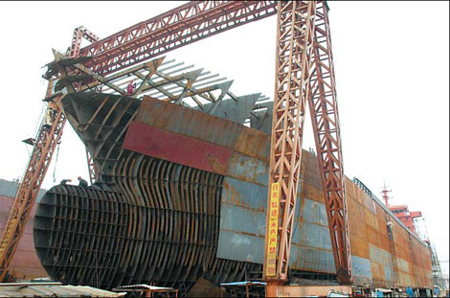
|
BIZCHINA> Center
 |
|
Plugging the leaks
By Qian Yanfeng (China Daily)
Updated: 2008-10-27 09:21 With the ongoing credit crunch and economic recession hampering worldwide trade growth, shipyards in China now face an abrupt downturn in demand and tighter access to credit after nearly a decade of freewheeling development in the industry.
 The estimated 3,000 or so shipyards have been expanding at a stunning rate on the back of the country's robust economic development as well as a global trade boom. With their cost advantage in a labor-intensive industry, Chinese shipyards may soon prove themselves to be the world's next shipbuilding leader very soon.
Last year, total orders at Chinese shipyards beat Japan, and were second only to South Korea. In terms of new orders, China already became No 1 in 2007, totaling 98.5 million deadweight tons (DWT), or 42 percent of the world's total. However, with the recent financial crisis affecting many economic sectors, the shipyards are starting to feel the pinch - ship buyers now are starting to hold back their orders while banks have tightened their fund guarantees amid gloomy market sentiments. According to a recent report from the China International Capital Corporation Limited (CICC), a joint investment bank in China, the number of new ship orders worldwide dropped 66 percent year-on-year in September. Chinese yards, in particular, experienced a 34 percent drop in new orders in the first nine months of this year, as compared to the global average of 27 percent. Guangzhou Shipyard International Company Limited, a subsidiary of China's shipbuilding behemoth China State Shipbuilding Corporation (CSSC), had only five new ships ordered in the first half of this year compared with 24 in 2007. Cheng Yang, purchasing manager of the Zhejiang-based Taizhou Wuzhou Shipbuilding Industry Co Ltd, says he and his colleagues in the sales department have been suffering from mounting pressure in the second half of this year as it has become increasingly difficult to secure new ship orders. "Shipyards did not need to look for orders in the past," says Cheng. "But now it is different. You have to go to the shippers to persuade them for a contract. "To be sure, we aren't the only victims. Many of the yards are coming under similar pressure, with some already delaying production. But once you know that, the sense of crisis simply gets intensified." Even the suppliers are starting to feel the stress. Cheng says he has had a growing number of shipbuilding suppliers visiting his office recently advertising their products. Obviously, the soft market demand has already passed into the upstream sectors. Industry watchers say with the Baltic Dry Index (BDI), the global benchmark for the cost of shipping commodities, tumbling over 80 percent from its May high to five-year-low in mid-October, the slumping demand for ships worldwide will continue. Underlying the slowing demand is the fact that even before the financial crisis set in, the shipping industry worldwide was already experiencing a capacity glut during the past five years. With 600 million deadweight tons of orders to be completed in the next three years, the global shipping sector is expected to have another 60 percent added to its current capacity, according to Ye Guoji, analyst from Ping An Securities. (For more biz stories, please visit Industries)
|